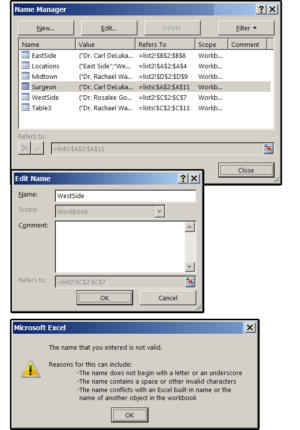

Now, let’s see why the delete option of the name manager greyed out and how we can fix this. The dataset contains some items and total sales in 3 months January, February, and March. To solve this problem we are going to use the following dataset.

But while deleting those ranges sometimes the delete button is greyed out or inactive. So, suppose you have created a lot of named ranges but you do not need these anymore so, you want to delete those named ranges. We create named ranges to make the workbooks simpler to understand, formulae quicker to enter and analyze, and the ability to construct variable-size ranges to keep our sheets flexible and updatable. See Morph transition: Tips and tricks for details.īy default, the most recently inserted object is at the top of the list in the Selection Pane, and the first object inserted is at the bottom of the list.Name Manager Delete Option Greyed out.xlsxģ Reasons with Solutions of Name Manager Delete Option Greyed out in Excel In PowerPoint for Microsoft 365, this ability comes in handy for using the Morph transition. Note: You can select multiple objects within a group, but you can't select objects within groups together with objects not in groups. If you select multiple objects by using ⌘ + Click, you can then group them or ungroup them by selecting Group Objects on the ribbon in the Format tab. Group or ungroup objects listed in the Selection Pane. The connector in the example above is hidden, and does not appear on the slide. To show the object once again, simply click the Hidden icon, and the object will reappear. The icon will change to a simple icon indicating that the object is Hidden from view. To hide an object, click the eye icon in the Selection Pane indicating that the object is Showing. In the example pictured, the connector is at the bottom of the list, and is behind the two oval shapes.Īfter the connector is moved to the top of the list, it appears in front of the two oval shapes.Ĭhoose to show or hide objects from the Selection Pane. In the example below from PowerPoint, moving the curved connector to the top of the list also brought it forward in front of the two oval shapes (and everything else on the slide). The Selection Pane opens with all your objects listed, and you can do any of the following:ĭrag an item up or down in the list to change the order. Format tab that appears on at the right end of the ribbon when you select the object, and then choose Selection Pane (or Arrange > Selection Pane). Select one of the objects you want to manage.
#Name manager in microsoft excel 365 for mac#
It isn't available in Office for Mac 2011. Note: This feature is available in newer versions of Microsoft 365 for Mac. Toggle the visibility of the item that has focus Move the focus among the items in the listĮdit the name of the item in the list that has focusĪdd/remove the item from the selection (that is, multi-select) Navigate by keyboard through the buttons in the pane and then into the list Move the keyboard focus through the major regions until it is in the Selection Pane You can use these keyboard shortcuts in the Selection pane: In Word, inline objects are listed in the Selection Pane, but you can't reorder them, hide them, or multi-select them.Īfter you select an item in the Selection pane, you can click again to change the name of the item.

To see an object that's under another object, you can hide the object on top temporarily, make the changes you want, and then show the object on top again. To make the object visible again, just click the "closed eye" button. On the right side of the item, click the "open eye" button. This feature should be used with caution, because it can be easy to entirely forget about a hidden object. Hiding an object keeps it in the file, but makes it invisible. You can select multiple objects within a group and the groups within it, but you can't select objects within groups together with objects not in groups.

For more information, see Group or ungroup shapes, pictures, or other objects. Format tab at the right end of the ribbon, select Group > Group (or Arrange > Group > Group).Īfter grouping the objects, you can format them or move or them on the canvas as a single entity. In the pane, use Ctrl+Click to select the items you want to group. Note: For an object that's in a group, you can only reorder it within the group.


 0 kommentar(er)
0 kommentar(er)
